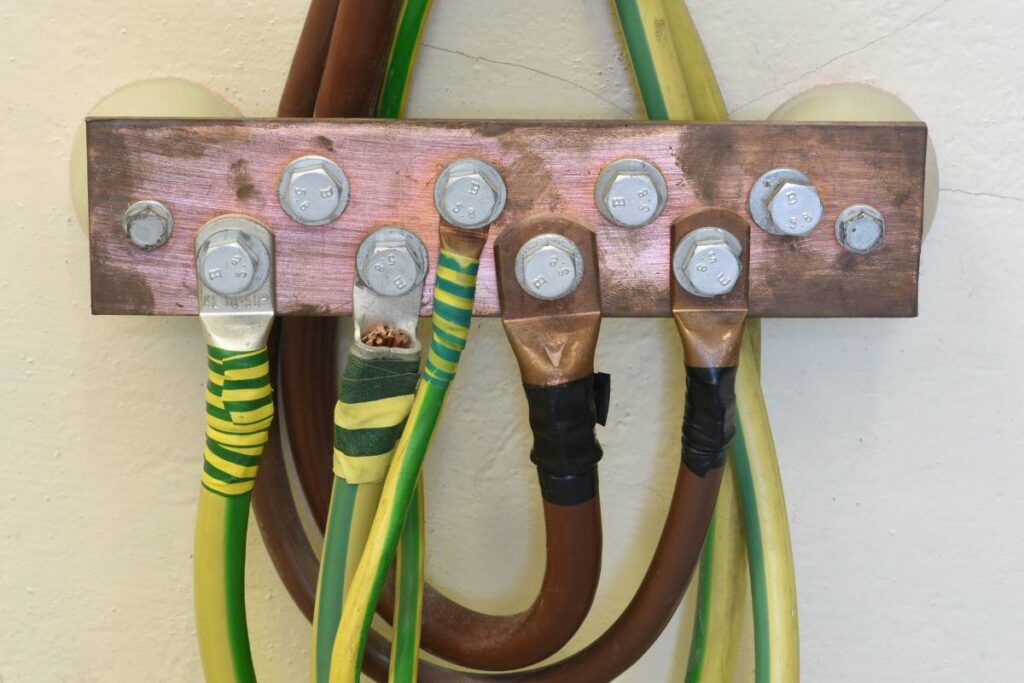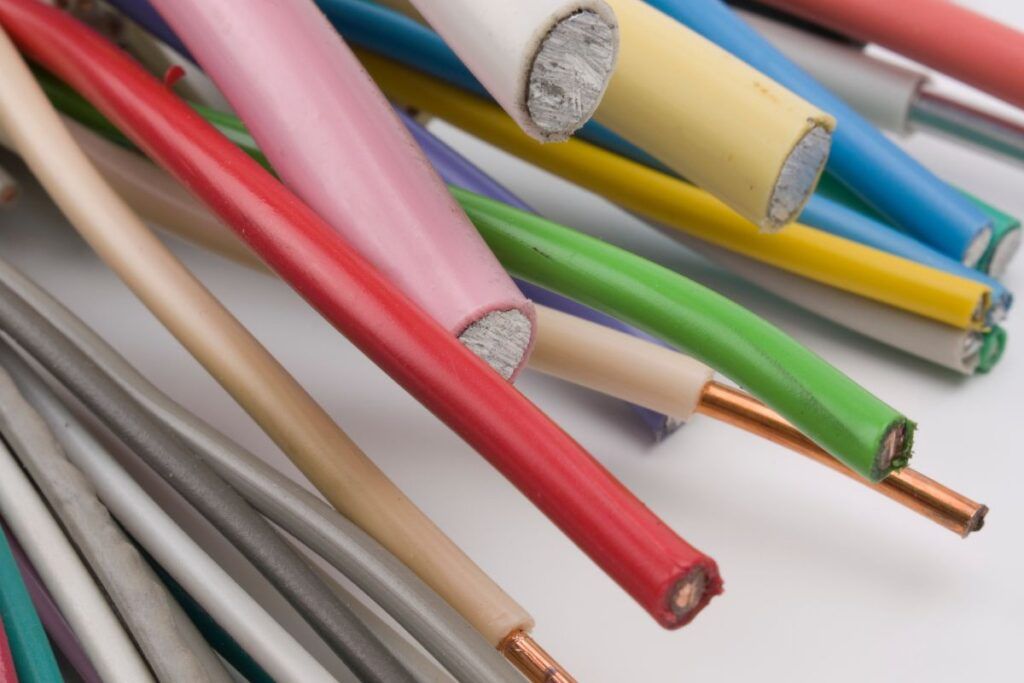Many homeowners, especially those new to the electrical systems, are confused about the neutrals and grounds and end up connecting them in the same bus bar. What happens if they are connected?
Generally, you should always avoid connecting the grounds and neutrals in the same bus bar. Connecting them to the same bus bars at the main disconnect panels of your house’s electrical system is recommended. But, never connect them in the subpanels.
Every house owner should know the basics of the electrical system in their house. This guide will share the basics and results of connecting the grounds and neutrals in the same bus bar and some safety measures.

Check out our list of top-handpicked products for all your electrical, appliance, and HVAC system needs to keep your home running smoothly.
This post includes some affiliate links.Understanding electrical grounds and neutrals
A residential electrical system gives power to your house.
The home appliances have three wires running together – hot, neutral, and ground wires.
Each wire has its role to play in the electrical system.
Without the wires, you cannot receive proper power and electrical safety.
First, let’s understand the grounds and neutrals.
Neutral wires
Every electrical circuit should be complete.
The neutral wire completes the circuit by sending the power back to the main source.
It is connected to the ground at the main panel, street drop, meter, and the final step-down transformer.
It is for simple panel installations. The neutral connection is more complex for multiple-panel installations.
Ground wires
The ground wires are green or bare wires that normally do not carry any current.
The wire is an alternate path for the current flow during a short circuit in an appliance.
When a short circuit occurs, the extra current needs an alternate path to flow. The ground wire is that path.
Without a ground, the current will flow through your body if you touch the appliance.
The ground wire will carry dangerous ground faults back to the breaker box and trip the breaker to protect you from an electric shock.
What about the hot wires?
The hot wire carries the electrical current from the main power source for the circuit to send it throughout the house.
We are, however, not concerned about this wire. But it is better to know the basics.
Be careful while working with the black or red hot wire.
It always carries current and should not be touched with bare hands or connected to any other wires.
The purpose of electrical bus bars in the electrical systems
A busbar is a metallic bar in the switchgear panel in the electrical system.
It carries electricity from the incoming feeders to distribute to the outgoing feeders.
In brief, the busbar is a junction that manages the incoming and outgoing electricity exchanges.
The bus bar system contains an isolator and a circuit breaker.
During any fault, the circuit breaker will trip, and the defective part in the bus bar easily gets disconnected from the circuit.
It contains several electrical lines working with the same voltage and frequencies.
These lines are used in the form of a pipe or thin-walled tube.
The electrical bus bars are arranged in various configurations.
The busbar arrangement’s role is to receive enough operation flexibility, sufficient reliability, and affordable cost.
The breakers are arranged to receive enough plant operations.
The busbars are of three types:
- Single bus bar system
- Double bus bar system
- Ring bus bar system
The difference between the ground and neutral bus bars

The main difference between the ground and neutral bus bars is their current path.
The neutral bus bar provides a return path for the current to the main power source.
The neutral bus bar ensures the loop is maintained and the circuit is complete.
On the contrary, the ground bus bar provides a path for the current to flow to the earth.
Below, we have elaborated on the difference for easy understanding:
Current carrying conductors
The ground bus bars are defensive against electrical shocks and short circuits.
So, the ground bars do not hold any current when everything is fine.
During a short circuit, there flows extra current.
The ground wire will carry this current to send it to the ground through the ground bar.
On the contrary, the neutral bars return the current to the power source carried by the hot bus bar.
So, the neutral bars will always carry current like the hot bus bars.
It will only swap with the ground bar during an electrical surge.
Current flow path
The neutral bar is where the current flows under regular functions to complete the circuit and take power back to the source.
On the contrary, the ground bar is where the current flows during an electrical fault.
Color and appearance
The neutral bars will always have white or gray wires connected.
On the other hand, the ground bars will have green or yellow wires connected.
Sometimes, it will be bare wires with no insulation.
The neutral bars are heavy and have high-current paths between the bare and neutral lug.
It is isolated from the chassis.
The neutral lug-to-bar connection is heavy.
The ground bars are in direct contact with the panel chassis.
You cannot remove or isolate them.
Connection configurations
The neutral wire can be made the central point of star configuration.
In this, you may connect all the hot wires.
On the contrary, you need a ground rod near the house for the ground wire and wire it back to the main panel for the current to leave.
Wire size

Along with the colors, the wire sizes can further distinguish them.
Since the neutral wire carries the same amount of current as the hot wire to return it to the main source, both will be of the same sizes.
For example, if you use a 4 AWG hot wire based on the breaker, you also need a 4 AWG for the neutral bus bar.
On the contrary, the ground wire will vary from the other two wires based on the breaker’s capacity.
For example, if you use 4 AWG for the hot and neutral bars, you can use a 6 or 8 AWG for your ground bars.
Additionally, the ground wire size from the main panel may differ depending on the service entering your house.
The codes and regulations regarding the separation of grounds and neutrals in electrical systems
The National Electric Code, or NEC, demanded the separation of the neutral and ground bus bars in 2008 in the NEC 250.32(B)(1).
According to the NEC, you should separate the ground and neutral wires in the subpanel and separate conductors back to the main panel when both panels are in the same structure. It was mentioned in 1999.
The need for separating the ground and neutral conductors in the subpanel in a separate building first appeared in NEC 2008.
You can look in the detached garage subpanel wiring diagram in the National Electric Code, or NEC, and see how they are wired.
Follow the following guidelines related to the ground and neutral separation:
- The main and the sub panels should be connected to the same ground potential only if there is the possibility of an underground grounding rod.
- Connect the subpanels to the main panel using the same path while you connect the ground and neutral on the main panel.
- You must connect the ground and neutral to the same bus bar on the main panel but keep them separate at the sub-panel.
- The NEC wants the contractor to attach the ground and neutral to the neutral bus bar in the main panel.
- The NEC also expects to have a connection between the neutral bar and the grounding electrode.
- When you see a neutral and ground connection in the same bus bar, contact an electrician to separate the connection and place them on separate bus bars.
The electrical safety implications of having ground and neutral on the same bus bar
Whether you can keep the ground and neutral on the same bus bar depends on two factors:
- Wiring the main service panel
- Wiring a subpanel
Main panel
If you want to keep the grounds and neutrals on the same bus, you should do it only in the main panel for safety.
Connecting the two connections in the same bus bar is safe for the main disconnect panels.
Such a connection for the main panel is made to save the electrical system during lightning strikes.
Suppose you connect the neutral and ground to the grounding rod.
In that case, the rod will send the misdirected electricity to the ground.
As a result, the same bus bar connections save your subpanels, circuits, wires, and appliances from frying.
Additionally, you can create a connection to the metal rod or other object that can act as a grounding electrode.
The connection will give you extra protection during a thunderstorm and lightning.
The main service panel is the entry point of your house’s electrical system.
The panel contains a single breaker rated for your house’s full electrical system.
The main disconnect is usually rated for 100 or 200 amps.
The requirement to connect the neutral and ground in the same bus bar is referenced in the NEC code in 2008.
Most building and electrical codes connect the main panel service with the metal ground rod according to the building code requirements.
Without the neutral-to-ground bond, the current will forcibly flow through the ground rod into the earth, reach the utility ground rod and the transformer, and go back to the hot wire to the breaker.
Subpanel
However, do not connect the grounds and neutrals in the same bus bar for the sub-panel.
A ground fault will occur if you connect the ground and neutral in the same bus bar on a sub-panel.
It will further energize the grounding wire, metal parts of the electrical system, and the circuits, resulting in dangerous electric shocks.
So, connect the ground and neutral on the same bus bar only on the main panel and not the sub-panel.
The effects of the current imbalance with combined grounds and neutrals
Connecting the neutral and ground in the same bus bar of the subpanel will create an imbalance in the electrical fields.
The hot and neutral wires are normally kept next to each other to offset their electromagnetic field.
The neutral current will not match up if the electricity flows through the ground wire.
The electromagnetic fields will cause issues due to the imbalance.
When the load gets imbalanced due to the ground and neutral bonding, the current will flow through anything connected to the sub-panel to return to the main panel.
It can be the enclosure, the ground wire, or the piping.
It will further lead to shock and fire hazards.
Electricity will take any path for returning to the main power source.
In simple terms, the neutral wires will be attached to a floating bar, and the grounds should be attached to the bar directly connected to the panel.
The reason for separating the grounds and neutrals in the electrical systems

It is challenging to understand the reasons behind separating the grounds and neutrals in the electrical systems.
It would help to keep them separate only in the subpanel and not the main electrical panel. But why?
Electricity will take any conductive course to return to the main power source and complete the circuit.
The neutrals act as a return path and thus always carry current.
On the contrary, the ground carries current only during a short circuit.
Let’s elaborate a bit.
When a ground fault occurs, the electricity will require a low-impedance path to the main panel to transfer the electricity to the transformer and back to the main power source.
When the ground and neutral remain in the subpanel’s same bus bar, the current will travel on both connections equally to return to the main panel. It further creates a ground loop.
For example, the refrigerator door is grounded. If the neutral and ground wires are in the same bus bar in the subpanel, the door will get electrocuted and shock you.
Best practices for maintaining the separation of grounds and neutrals in the electrical system
It is fine if your ground and neutral are connected to the same bus bar in the main panel.
If the connection is the same for the subpanel, you should separate the ground and neutral and put them in different bus bars.
Since it involves electrical wires, you need to be careful during the separation:
- First, turn off the power at the main panel and test it with a multimeter.
- The hot wires will have the maximum voltage and amperage, and the white wire should have the maximum amperage but minimum voltage. The grounding will have minimum voltage and amperage.
- If the ground and neutral are connected, the ground will have the same voltage and amperage.
- You should disconnect the ground from the neutral bus bar and connect it to a separate bus bar in the subpanel.
The best practices while maintaining the separation of the two connections include:
- Turn off the power before you start working with the separation.
- Check the power at the main panel with a multimeter or non-contact voltage tester to confirm that the power is off and there is no voltage.
- Make sure you use a separate bus bar for the grounding with no hot or neutral wires connected.
- Ensure that you have secured the wires tightly to their respective bus bars. Otherwise, loose connections can cause electrical accidents.
- After you have separated the wires, check the connection for its proper functioning.
- Call an electrician to fix the problem if you cannot fix it.
- Wear protective gear and avoid working over wet areas.
- Avoid contacting outside metal while working.
The role of alternating current (AC) in the electrical systems
The electricity is delivered through two types – direct current and alternating current.
We know the role of the direct current in the batteries.
Every battery will have a positive and negative connection.
The current flows in one direction from the positive to the negative terminal.
In the alternating current, the electricity is delivered to the end-user.
The alternating current does not flow in one direction like the DC but oscillates.
It starts in one direction and then flows in the opposite direction.
Alternating current is considered more efficient for delivering current in large-scale grids.
The alternating current boosts to high voltages for transferring current over long distances.
It further reduces the current to the normal 120V at our houses.
In the US, most people use alternating currents for standard electrical systems.
Final thoughts
The grounds and neutrals are integral to your house’s electrical systems. Connect them in the same bus bar at the main panel, but must separate them in the sub-panel.
Keeping them together in the main panel saves your electrical systems from burning during electrical accidents.
But connecting them in the subpanel will energize the ground wire and every other metal part of the subpanel, resulting in short circuits and fire.
The neutral carries the same amount of current as the hot wire as it returns the current to the main power source.
But the ground only carries power if there is a short circuit. The current needs an extra path for the extra current and saves you from getting electrocuted.
So, connecting the ground and neutral in the same bus energizes the ground and stops it from serving its purpose. While separating the ground from the neutral, ensure that the power at the main is off.
Check the bus bars to confirm that there is no voltage. After you have separated them, check the functionality of the subpanel and your house’s electrical system.
Won’t GFCI breakers protect the house from ground faults?
GFCI breakers protect the house from electrical accidents by tripping whenever they sense danger. It gives extra protection but cannot protect your house from high-voltage electricity surges like grounding.
Can ground and neutral be together in the same breaker box?
You can connect ground and neutral in the same bus bar at the breaker box, provided it is the main panel. If your ground and neutral wires are mixed in any place besides the main breaker, call an electrician to separate them.
Reference: Ground and Neutral Wikipedia



Great, straight forward analysis of use of grounds and neutrals in both the primary panel, as well as any sub-panels one might have. Thank you!
I am glad that was helpful!